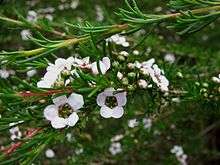Astartea fascicularis
Astartea fascicularis is a species of flowering plant in the myrtle family, Myrtaceae. It is endemic to southwestern Western Australia, where it is widespread in the Recherche Archipelago and present on the mainland in Cape Le Grand National Park. It is commonly known as Recherche astartea.[1] or false baeckea.[2]
| Astartea fascicularis | |
|---|---|
 | |
| Scientific classification | |
| Kingdom: | Plantae |
| Clade: | Tracheophytes |
| Clade: | Angiosperms |
| Clade: | Eudicots |
| Clade: | Rosids |
| Order: | Myrtales |
| Family: | Myrtaceae |
| Genus: | Astartea |
| Species: | A. fascicularis |
| Binomial name | |
| Astartea fascicularis | |
Description
This species is a shrub usually reaching up to 1.5 metres tall at windy sites and about 3 metres in maximum height in sheltered areas. It may have single or multiple stems and may layer. New stems are reddish in colour and ridged or winged. Older stems are grey, developing reddish and grey stripes, and more deeply ridged. The leaves are often arranged in fascicles. The leaf blades may be as thick or thicker than they are wide, and reach 1.2 centimetres long. The flowers are paired along the branches. The petals are usually white, or sometimes pale pink. The flower contains clusters of several stamens and usually a few staminodes. The fruit capsule is 2 or 3 millimetres long.[1]
Distribution
It has a scattered distribution in the South West, Great Southern and Goldfields-Esperance regions of Western Australia where it is often found along watercourses and in winter wet depressions growing in sandy and lateritic soils.[3]
This shrub grows on granite substrates. It occurs in exposed coastal habitat and more protected inland scrubs.[1]
References
- Rye, B. L. (2013). A revision of the south-western Australian genus Astartea (Myrtaceae: Chamelaucieae). Nuytsia 23, 189-269.
- "Astartea fascicularis - False Baeckea". Growing Native Plants. Australian National Botanic Garden. Retrieved 3 June 2017.
- "Astartea fascicularis". FloraBase. Western Australian Government Department of Parks and Wildlife.
External links
- "Astartea". Australian Plant Name Index (APNI), IBIS database. Centre for Plant Biodiversity Research, Australian Government, Canberra. Retrieved 2008-01-26.